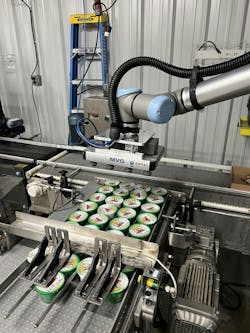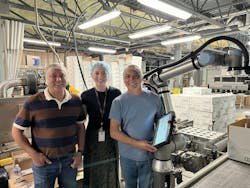Robot Helps El Pinto Foods Increase Packaging Efficiency
Oct. 8, 2024
4 min read
Albuquerque, New Mexico-based El Pinto Foods operates a restaurant and manufacturing operations, where it provides co-packing and private labeling services. The company offers a range of products, including salsas, marinades, dipping sauces and dressings in containers such as glass jars, plastic bottles, single-serve cups and PET containers.
A recent production goal for El Pinto involved improving the efficiency of its salsa production. The main efficiency challenge faced by El Pinto was the manual loading of labeled, single-serve cups into box trays for shipping. This process required three to four employees. The inefficiency of this manual process, in addition to the complexity of manually handling various packaging formats, often led to equipment downtime.
To improve this process, El Pinto Foods reached out to In-Position Technologies to help streamline the company’s manufacturing process and reduce its dependency on manual labor.
Robotic tooling issues
A key issue for In-Position Technologies when figuring out how best to handle El Pinto Foods’ products involved the design of a single end-of-arm tool (EOAT) that could handle the variances of El Pinto’s packaging. According to Annalise Hildebrand, In-Position Technologies’ New Mexico sales engineer, the varying weights and surfaces of the products, including different peelable lids and shrink wrap, required a sophisticated approach to ensure consistent handling.
This EOAT would also require a compact form factor to fit within the box trays without disrupting the product alignment.
Hildebrand noted that, for this project, In-Position Technologies focused on El Pinto’s single-serve cups, as that line was the bottleneck of the process due to its manual processing. “The single-serve cups have varying plastic sealing and weights based on if they contain salsa or marinara,” she added.
In-Position Technologies designed a customized pneumatic gripper for a Universal Robots’ UR10e to tackle El Pinto Foods’ operational challenges. “Collaborating with Coval Vacuum, we designed a gripper that handles various product types and weights while fitting within the space constraints,” said Hildebrand. “Our solution involved extensive testing and CAD modeling to ensure seamless integration with El Pinto’s production line. Coval provided part testing and guidance, helping us refine the gripper to meet El Pinto’s requirements.”
Hildebrand explained that the custom gripper was designed to pick up 12 cups because the box that the cups are shipped in requires layers of 12 cups with varying stack heights. “With this gripper, the robot could repeatably place the 12 cups and could be programmed for different layer configurations depending on the box,” she said.
The CAD modeling used to design the gripper was based on cup size and box size to ensure that the entire gripping module fits inside the walls of the box. Hildebrand noted that, in this design process, there were several iterations involved, including taking the silencer off to reduce the overall length, positioning the suction cups perfectly, and fabricating an interface plate between the UR tool flange and the gripper.
A pneumatic gripper was chosen by In-Position Technologies because interfacing with the packaging on the top allows for the cups to be tightly aligned, which is crucial to optimizing how many can be picked and transferred into the box. “With other grippers, such as a 2-finger mechanical gripper, it would require a certain amount of space between cups to allow the gripper fingers to grab the sides, which would mean we couldn't pick and place all 12 cups with one pick,” explained Hildebrand.
Achieving the required production efficiency
The In-Position Technologies team assisted El Pinto with setting up the components, integrating the conveyance system and programming the robot for production.
Within a few weeks, El Pinto Foods was able to start production, reducing a three- or four-person process to just two with the help of robotics. Beyond the reduction in manual labor, the speed of packaging with the robot has been a huge benefit for El Pinto as the layer of 12 single-serve cups can now be picked up at once. Hildebrand explained that, when the process was performed manually, only one or two cups could be picked up by hand at a time. This means El Pinto benefits from increased throughput, enabling the company to handle rapid product surges more efficiently.
“This transition not only helps them better handle product surges, it also instilled confidence in further robotic integration at El Pinto Foods,” said Hildebrand. “This project has led the El Pinto manufacturing team to consider further use of robotics in their processes. We’ve uncovered several other places in their process that could benefit from robotics and have started those conversations already.”
About the Author
David Greenfield, editor in chief
Editor in Chief
David Greenfield joined Automation World in June 2011. Bringing a wealth of industry knowledge and media experience to his position, David’s contributions can be found in AW’s print and online editions and custom projects. Earlier in his career, David was Editorial Director of Design News at UBM Electronics, and prior to joining UBM, he was Editorial Director of Control Engineering at Reed Business Information, where he also worked on Manufacturing Business Technology as Publisher.
Sign up for our eNewsletters
Get the latest news and updates




